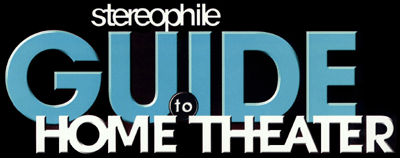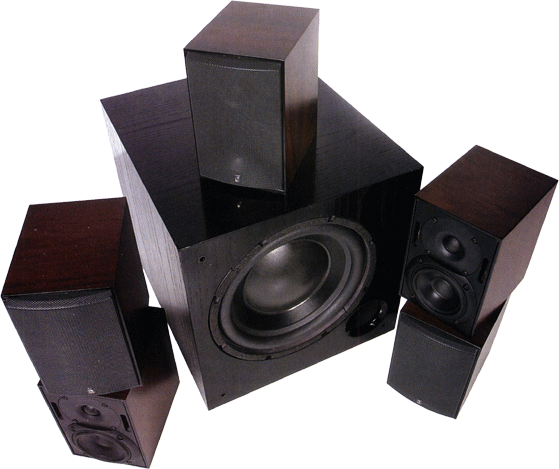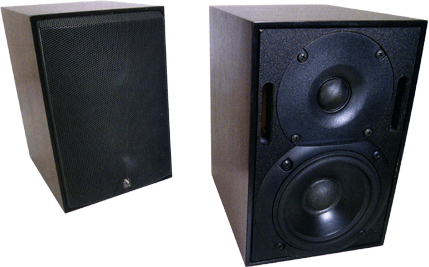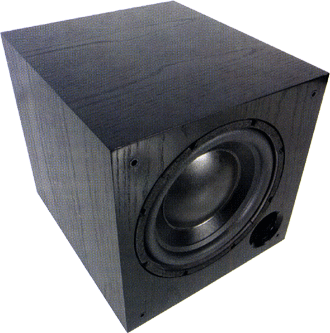
Alón by Acarian Systems Napoleon
January 2004
By Michael Fremer
 Veteran speaker designer Carl Marchisotto has created many highly
regarded 2-channel audiophile speakers over the years for his Acarian
Systems brand. But the Napoleon mini home theater system is the first
dedicated home theater speaker package from Acarian that I can recall,
and the first I have reviewed for SGHT.
Veteran speaker designer Carl Marchisotto has created many highly
regarded 2-channel audiophile speakers over the years for his Acarian
Systems brand. But the Napoleon mini home theater system is the first
dedicated home theater speaker package from Acarian that I can recall,
and the first I have reviewed for SGHT.The Napoleon system is comprised of five diminutive, identical satellites and a sub-woofer. Each shielded 2-way satellite weighs a mere 10 pounds and comes in attractive Brazilian Santos Rosewood or Black Ash veneers, with a metal mesh grille. The 4½-inch bi-laminate woofer crosses over to the 1-inch silk-dome tweeter at 3.5 kHz through a hand-wired network that uses an air-core inductor and polypropylene capacitors. Driver quality and cabinet construction are good.
The Thunderbolt is a compact, 85-pound, front-vented subwoofer with a custom 12-inch, ultra-long-excursion, Kevlar-reinforced pulp-cone driver with a cast frame and massive double-stacked magnet. The sub is driven by a discrete, class-A/B non-servo amplifier, the power of which is not specified.
The Thunderbolt is rated from below 20Hz to 160Hz. Alón recommends it for use with its far more expensive systems, so I figured it was well up to the task of partnering the Napoleon satellites. The sub's rear panel has an output-level control, a low-pass filter continuously variable from 40Hz to 160Hz (the high-pass filter is fixed at 125Hz), a variable 0-180° phase control, one set each of high-level input and output speaker binding posts, and 2-channel line inputs and outputs. The amplifier sits in a separate MDF cabinet within the main cabinet.
The Thunderbolt's build quality and fit and finish are excellent. The cabinet is made of 1-inch-thick MDF and is glued with adhesive rather than the hot melt glue used for most subwoofers. The sides are pressure-clamped during drying; this, together with the cabinet's dual front baffle, ensures excellent rigidity; Based on the ol' knuckle-rap test, the enclosure seemed very well-braced and -constructed.
The 12-inch driver has a massive cast basket and magnet assembly. The relatively light, Kevlar-reinforced cone of natural-fiber pulp provides excellent stiffness, greater efficiency; and is easier for an amplifier to control. Alón maintains that a high-mass driver's greater inertia takes longer to start and stop, thereby interfering with bass transients. Designer Carl Marchisotto doesn't use servos in his subs because he claims that, no matter how fast the servo, by the time it has compared input with output and applied its correction, the woofer is reproducing the next cycle, which leads to compression and loss of transient clarity.
Setup
 Carl Marchisotto paid me a visit to set up the Napoleon system. He set
one pair of satellites on rigid stands on either side of my monitor,
and another pair at opposite ends of my couch in the rear; all at
approximately ear height. A single Napoleon was placed atop my 65-inch
Hitachi RPTV and aimed down toward the listening position. That tiny
tot sure looked lost. Marchisotto pulled the Thunderbolt subwoofer way
from the front wall and angled it slightly into the room. As usual, I
let the manufacturer do his thing, then did mine after he'd left. The
sub eventually ended up in my customary left-corner spot.
Carl Marchisotto paid me a visit to set up the Napoleon system. He set
one pair of satellites on rigid stands on either side of my monitor,
and another pair at opposite ends of my couch in the rear; all at
approximately ear height. A single Napoleon was placed atop my 65-inch
Hitachi RPTV and aimed down toward the listening position. That tiny
tot sure looked lost. Marchisotto pulled the Thunderbolt subwoofer way
from the front wall and angled it slightly into the room. As usual, I
let the manufacturer do his thing, then did mine after he'd left. The
sub eventually ended up in my customary left-corner spot.
Marchisotto claims that the Napoleon system sounds best with the satellites driven full-range to avoid the preamp-processor's crossover, but as good as his speakers might be, they can't defy the laws of physics: I don't see or hear the value in trying to put very low frequencies through a 4½-inch woofer if it can be avoided - especially in a home theater system, and especially if the preamp-processor has a high-quality internal crossover. In any case, if your processor can't simultaneously feed the bass to the subwoofer when set for Large speakers, you'll miss a great deal of bass information with satellites that can't go below 80Hz.
The trickiest part of setting up a small satellite-subwoofer system is getting the sub to blend with the sats without leaving a hole in the middle, or creating boominess and overhang in the crossover region. Alón recommends balancing the sub's output level with the main speakers before fine-tuning the crossover. Then, if your receiver or pre-pro offers only the THX standard 80Hz crossover, Alón recommends setting the Thunderbolt's variable low-pass filter to 160Hz to avoid a double crossover when using the Napoleons. Otherwise, Alón suggests setting the crossover in the electronics to 200Hz, then using the Thunderbolt's variable crossover to blend it with the satellites. Finally, you set the variable phase control (0-180°) to create the most coherent low-frequency picture. Alón smartly recommends a good recording of a bass drum to arrive at the most coherent sonic picture.
 Listening
Listening
The star of the Alón Napoleon assemblage was the subwoofer. I've heard a lot of subs in my day, and the Thunderbolt was easily one of the most musical. It's a true subwoofer, capable of close to 20Hz response. Whether because of the cone material, the lack of a servo system, or both, the Thunderbolt was among the fastest; least colored subs I've heard. Even when required to deliver frequencies up to around 100Hz, the Thunderbolt neither gave away its location nor produced annoying "one-note" bass. Instead, it produced the combination of weight, coherence, and leading-edge detail that makes bass performance believable and appropriately sized. What's more, this relatively small box could play loud without strain or compression.
And if any subwoofer could be characterized as nimble, it would be the Thunderbolt. It didn't have quite the almost overwhelming weight and foundation-shaking power of the much larger Aerial SW-12 ($5000), but at $1695, the Thunderbolt should be on anyone's subwoofer short list for its ability to deliver bass delicacy, detail, and definition along with formidable weight and extension. It shook my room reproducing large explosions, and it delivered the sensation of a timpani being thwacked or a cello being bowed - even when used with the tiny Napoleon satellites.
Back in the spring of 2001 reviewed a 5.1-channel satellite-subwoofer system from Edge Audio - now Aperion Audio - sold only via the Internet. The package consisted of five small 2-way satellites plus a powered subwoofer featuring a front-ported, front-firing long-throw 12-inch driver. For a grand total of $1399, the system offered surprisingly fine performance and reasonably high build quality; along with some unusual features, including the patented DiAural crossover technology; which is said to have certain advantages over more standard crossover designs. The Edge system had many laudable qualities, but I found the overall sound to be "stuffy and congested" and lacking in perceived high-frequency extension. You can't have everything for $1399.
I was interested to hear what $2995 would buy today; compared to what I remembered of the sound of the then $1399 Aperion/Edge system. The Aperion was no longer on hand, but I did play some of the same music tracks on the Alón package that I had used to evaluate the Aperion system, including: James Taylor's Live at the Beacon Theater (Columbia Music Video CVD 50171); Jonathan Demme's superb Talking Heads concert, Stop Making Sense (Palm Video PalmDVD 3013-2) and Sessions at West 54th Street (Columbia Music Video CVD 50163).
Whether because of the DiAural crossover or something else, my sonic recollection was that the Aperion/Edge system produced a larger, more spacious picture overall; otherwise, the Napoleon system was the hands-down winner - which, at twice the price, it should be. The Thunderbolt's fast, articulate bottom end delivered stunning results with Suzanne Vega's "Caramel," with super-tight bass attack and properly sized, pleasing heft. Whereas the Aperion/Edge system had sounded closed-in, congested, and lacking in air and transparency, the Napoleons sounded open, transparent, and easy on the ears. The transients of acoustic guitar strums were cleanly rendered, and the balance between the attack and the resonance of the instrument's wooden body produced a believable guitar sound free of boxiness, hollowness, or bloat.
Switching to films, as California's new governor motorcycled through the storm drains of Sherman Oaks in Terminator 2, chased by Gray Davis - er, I mean the T1000 sent to destroy him - his shotgun blasts had plenty of impact; and in terms of both weight and articulation, the explosion of the gasoline tanker truck was something a much bigger system would have been proud to reproduce. (Can an explosion be articulate?)
But even with the system dialed-in perfectly there was still a loss of lower-midbass bloom and richness with the Napoleon-Thunderbolt system that left the entire sonic picture a bit lightweight. Such a lack of midbass richness often translates into center-channel dialog that's slightly thin and lacking in ultimate believability - but thanks to the clarity, articulation, and freedom from bloat and overhang of both the Thunderbolt and the Alón satellites, male and female voices were pleasing and intelligible if not fully formed. It's always easier to ignore an omission than to try to cut your way through a tacked-on coloration such as chestiness or muddiness. The Alóns' off-axis response seemed smooth and free of major dips at normal distances (but leave it to TJN's measurements to show some major troughs!).
Five small, identical satellites will almost always create a large acoustic bubble, and the Alón Napoleon system was no exception. Visitors - especially experienced audio/videophiles - were as uniformly impressed by the system's wide-open tonal balance and crisp clarity as they were by the scale and integrity of the 5.1-channel presentation; but when dialog was emanating from the center channel, it sounded small. Toward the end of the two months I spent with the Napoleon system, Linn's Unidisk universal disc player arrived and I was assigned to review a stack of multichannel DVD-Audio and SACD discs. Because Carl Marchisotto's background is in designing speakers for 2-channel music reproduction, it should come as no surprise that this little system performed remarkably well at this task. Still, I wasn't surprised when I set up an Aerial surround system costing well over $30,000 and heard an enormous improvement.
This is a fine-sounding small system with a top-shelf subwoofer, but it can't perform miracles of timbral richness, tonal neutrality, dynamic slam, spaciousness, or resolution of low-level detail, so don't expect them. For instance, the 5.1-channel mix of the Beach Boys' Pet Sounds (Capitol 72434-77937-9-0) produces an enormous, cavernous spatial picture, with great weight. The Napoleon system created a fine musical performance, especially rhythmically but couldn't come close to delivering the weight, space, or delirious richness I got from the Aerial system. It shouldn't be expected to.
Conclusion
The petite Alón Napoleon system offers a combination of pluses and minuses anyone constrained by space should consider. As in the $1399 Aperion system to which I compared it in this review, the star of the Alón system is its subwoofer, available separately for $1695. The Thunderbolt sub is an exceptional performer regardless of price, and it's worth considering under any circumstances, but especially if your home theater has serious space limitations and doubles as your music system. Is the Thunderbolt worth three times the cost of the sub supplied with the Aperion/Edge system? I don't know about the sub Aperion currently offers, but compared with the one I reviewed, absolutely. The Thunderbolt is built to a higher level of quality and goes way further down, while managing far greater musical suppleness and sophistication.
The question is, how much are you willing to spend for five tiny, not particularly stylish satellites? While I could list a number of other small 2-way satellites (such as the NHT SB-2 at $400/pair, the PSB Alpha B at $249/pair, or the Paradigm Atom at $189/pair) that would seem to offer more speaker and/or more style for the same money or a few dollars more than the little Napoleons, there's no way I can guarantee better performance without actually hearing those combinations.
Perhaps part of the secret of the Alón system's success is that its designer considered the speed and detail of his Thunderbolt subwoofer when designing the Napoleons. The fact that the satellites' bass performance is undernourished but articulate is perhaps the key to their noteworthy integration with the Thunderbolt, and to the overall long-term listening satisfaction I got from this system.
In the world of high-end audio from which this system springs, value is measured as much, if not more, by subjective performance as by the total cost of the parts used. Is the Alón Napoleon system worth twice as much as the Aperion/Edge system I reviewed a few years ago? Considering the Napoleons' airy open, uncongested top end, the superbly nimble, deep, and musical bottom end of the sub, and the overall easy listenability of the system as a whole, I'd have to say yes. Whether it's worth spending more than a few thousand dollars on any mini-satellite-subwoofer system is another question. You'll have to answer that one for yourself.
|
| ||
|
Napoleon 2-way shielded satellite speaker with dual
front ports Drivers:1" silk-dome tweeter, 4½ bilaminate woofer Frequency Response: 80Hz to 22,000Hz Crossover frequency: 3.5kHz Impedance: 8 ohm nominal Sensitivity: N/A Power handling: N/A Finishes: Brazilian Santos rosewood, black ash veneers Dimensions: 8"H x 5½"W x 7"D Weight 10 lbs. each
|
Thunderbolt powered subwoofer Driver:12" cast-frame, ultra-long excursion Kevlar reinforced-pulp cone Amplifier: N/A Frequency Response: 20Hz to 160Hz, +/- 3dB Finishes: Gloss black ash, cherry Dimensions: 16"H x 16"W x 18"D Weight 85 lbs. Price $1695
|
System price $2995
Manufacturer
|